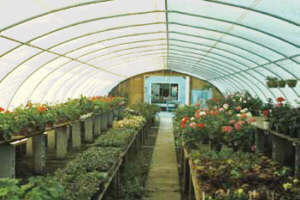www.mybaycity.com
April 10, 2010
(Prior Story) Business ArTicle 4811 (Next Story)
Sponsored by Bay Area Chamber of Commerce
Can Agriculture and Farmer's Markets Save the Michigan Economy?
|
||||||||||
| Printer Friendly Story View |

Hoop houses are constructed from bent tubular pipe for the framework, which is then covered with some type of plastic. The C.S. Mott Group for Sustainable Agriculture at Michigan State University suggests a massive hoophouse project to stimulate urban ag.
Agriculture in Michigan is increasingly being viewed as an answer to the economic downturn of manufacturing, according to Bay County Executive Thomas L. Hickner.
But first attitudes of state residents need to be changed, he said, stressing the economic benefits of such trends as technology in agriculture, urban agriculture, farmer's markets and other ways to spread the use of locally grown foods.
Michigan has 56,014 farms cultivating 10 million acres, with farms averaging 179 acres each, according to the Michigan Association of Counties (MAC). Single family operations and/or family partnerships account for 95 percent of all farms.
Food and agriculture produces $71.3 billion a year, making it second only to manufacturing. Agricultural exports are growing five times faster than the general economy.
Ag and supportive industries employ about 1 million in Michigan, about one-quarter of the workforce. On-farm payrolls are about $607 million a year for 86,000 employees producing 200 plus commodities.
Michigan is second only to California in agricultural diversity, according to Bob Boehm, commodity and marketing department manager at MAC.
MAC projects $211 million increased net income and 1,800 off-farm jobs if Michigan residents bridged "the public health gap." That involves shifting from current consumption to public health recommendations regarding eating more fruits and vegetables and locally grown crops.
Kathryn Colasanti, academic specialist of the C.S. Mott Group for Sustainable Agriculture at Michigan State University, says there are unrealized economic opportunities in urban agriculture.
An additional 5,000 30 foot x 96 foot unheated hoop houses could produce 12 - 25 million pounds of vegetables worth about $25 to $100 million a year, she said. Some of the hoop houses could be at schools where they would be tools for science, math, geography instruction and food studies, she said. Such a project would require a capital investment of about $75 million.
In line with these initiatives, the Michigan Farm Market Association (MIFMA) will host a free Farmers Market Forum will be held noon-2pm Saturday, April 25 at Sullivan's Black Forest downstairs in the Meyer Room, across from Bronner's Christmas Wonderland in Frankenmuth.
Intended for farmers, producers, vendors, market managers, city government, and local food and market enthusiasts, this event is coordinated by the Michigan Farmers Market Association (MIFMA) in celebration of its birthday that week.
This forum will be a chance to meet fellow farmers and market enthusiasts in the area, network with and learn from each other, showcase and sell your product at a MIFMA Mini-Market, discover shared challenges everyone in the area is facing, and identify opportunities where we can all work together while preparing for a fantastic market season in 2009.
Shared concerns will be taken back to the MIFMA Board of Directors. In addition to ordering lunch and some top-notch locally crafted brews, you will also be able to learn about MIFMA and even join as a member.
At the Forum, participants will share 2010 market plans, market trends and news, will explore cooperative efforts and participate in the MIFMA Mini-Market to show and sell products.
Please RSVP to dbronner@chartermi.net or call (989) 245-0806, as soon as possible, or by April 21. Please invite any others that may be interested or who do not have email.
The C.S. Mott Group at MSU says approximately 37,000 more acres of production are needed to reach full potential in the locally grown food segment of the agricultural economy.
The W. K. Kellogg Institute for Food and Nutrition Research (WKKI) says 18 percent of grain, flour, fruit, honey and other food products are from Michigan producers. The institute projects $54 million in private investment over the next decade and 300 new jobs in food science research and development.
| Printer Friendly Story View |
|
|

Dave Rogers |
|
|
|
Printer-Friendly Story View
0200 Nd: 04-22-2024 d 4 cpr 0
12/31/2020 P3v3-0200-Ad.cfm
SPONSORED LINKS
12/31/2020 drop ads P3v3-0200-Ad.cfm


